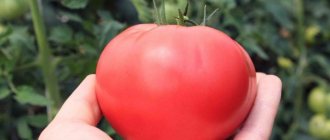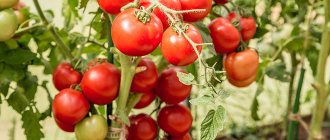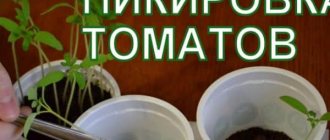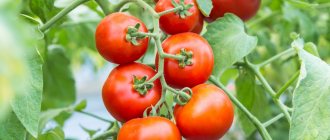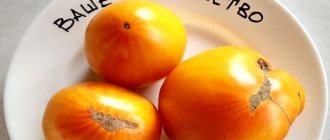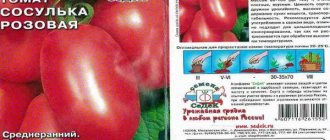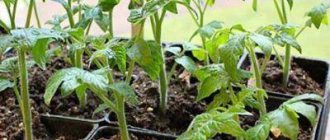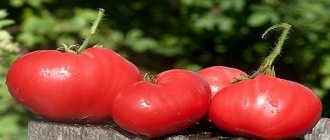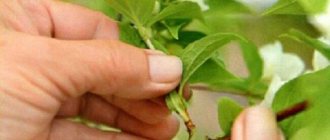See excellent harvests with your own eyes. Pick neat tomatoes with your own hands. Anyone who plants a Nastya Siberian tomato will be able to enjoy the amazing taste.
| Height | Landing location | Ripening time | Fruit color | Fruit size | Origin | Fruit shape |
| short | Greenhouse, Open ground | Mid-early | Reds | Average | Variety | Plum-shaped or oval |
Features of variety selection
If a summer resident plans to grow tomatoes in Siberian conditions, then he must take into account the fact that summer in this region is quite short, and the average temperature is much lower.
That is why it is necessary to give preference to zoned crops. If you plant any other tomato, there is a high chance of getting unripe, tasteless tomatoes or not even picking a single fruit from the bush. The main properties that should be taken into account when choosing a variety are:
- Early ripening - late tomatoes will not have time to ripen in short summer conditions.
- Resistance to late blight also plays an important role. In harsh climatic conditions, plants are planted in greenhouses, where air humidity is always higher than in open ground. This can trigger outbreaks of late blight.
- The height of the bush - the taller it is, the more problematic it is to grow it in a greenhouse. If the dimensions allow you to plant indeterminate plants, then you can safely do so. However, you will have to build special supports for them and tie the shoots to them in a timely manner. Untied branches may break under the weight of the fruit.
- Resistance to low temperatures. In the conditions of the Siberian summer, significant cold snaps are possible and ordinary tomatoes will not be able to cope with them.
It is also worth considering the purpose of the variety. There are tomatoes for canning, salad, and also those that can easily withstand long-term storage and transportation. Based on your needs, you need to choose one thing, although breeders have already been able to develop plants for universal use.
How to grow tomatoes
At the beginning of May, the seedlings are sent to the greenhouse. At the end of May, planting under film shelters is possible, and in open ground - not earlier than June.
Landing
Planted according to the following scheme: 40 cm - distance between seedlings, 60 cm - row spacing. No more than 4 plants are placed per 1 m2.
The holes are prepared in advance; a little ash or sawdust is placed on the bottom of each. The seedlings are buried to the first leaves, watered with warm, settled water and left to get used to the new conditions for 1 week.
Further care
Water regularly as young bushes take root. It is not recommended to over-water the beds - this can lead to rot. Optimal watering is 2 times a week, at least 3 liters for each plant. To keep the beds moist longer, they are mulched.
After watering, the soil is loosened, improving oxygen access to the roots. Removing weeds is necessary to reduce the risk of fungal diseases. In addition, weeds extract many useful substances from the soil.
The first fertilizing is applied 2 weeks after transplantation. Fertilize with a full complex of minerals. The second feeding is applied at the time of formation of ovaries. Here they use a water infusion of mullein in a ratio of 1:10. The third time the plants are fed at the time of fruiting with a full complex of minerals with the addition of potassium salts.
Features of care and possible difficulties
Culture needs mandatory formation. The bush is led into 1 stem, otherwise the yield will noticeably decrease and the fruits will be smaller. No more than 6 fruiting clusters are left on the stem, each of which has no more than 5 ovaries. With this care, fruiting will delight you with larger and more juicy vegetables.
Stepchildren are removed regularly to prevent the plantings from becoming dense. The procedure is carried out in the morning so that by the evening all the wounds have time to heal. For faster healing, the sections are sprinkled with wood ash.
During transplantation, a wooden or metal support is installed next to each bush. The stem is fixed almost immediately during transplantation so that it is formed even and strong. As they develop, fruit-bearing branches are also tied to the support, since they will not support the weight of ripe fruits.
Diseases and pests
The tomato is highly resistant to diseases such as late blight, brown spot and fusarium. However, for the purpose of prevention, it is necessary to carefully examine each seedling in order to notice any changes in time. In addition, plant inspection prevents the spread of pests.
In addition, preventive methods include:
- moderate watering and control of humidity levels;
- removal of weeds with roots;
- loosening and mulching;
- ventilation of the greenhouse.
When transplanting, seedlings are sprayed with a pink solution of manganese, and the soil is spilled with copper sulfate.
If the plants are still affected by a fungus, fungicidal agents (for example, Fitosporin) are used for treatment. Seedlings are also treated with the same product for preventive purposes.
The most dangerous pests are whiteflies and aphids. Aphids are gotten rid of by treating the stems with a soap solution. It is prepared from 1 piece of laundry soap dissolved in a bucket of water.
To combat whiteflies, pheromone traps are used and sharp-smelling herbs are planted next to the tomato, which repel the pest with their smell. Such plants include basil, onions and garlic, mustard bushes. When there is a large concentration of whiteflies, the insecticide “Confidor” is used.
Siberian varieties
The market offers a huge selection of seeds for growing in Siberian conditions. From this assortment, everyone can choose the right food according to their requirements.
One of the most popular varieties is Siberian early ripening. The period from the appearance of the first shoots to the beginning of fruit ripening takes an average of 115 - 130 days. The bush is determinate, about 45 - 50 cm high. The leaves are dark green with a light fluff on the back side.
The tomatoes are quite large. Their weight ranges from 70 to 120 g. The fruits are fleshy, round, and the skin is dense, which makes it easy to transport tomatoes without compromising their presentation. It is also distinguished by high productivity. From 1 m² you can get up to 10 – 11 kg of harvest.
Fruits can be consumed in any form
The fruits are ideal for fresh consumption, as well as for whole-fruit canning. Due to the dense structure of the pulp, they can be used to prepare sauces and tomato paste. Despite all its advantages, the tomato is becoming obsolete. It is difficult for him to compete with modern hybrids.
Malachite
The Siberian tomato variety Malachite has quite unusual fruits. Its ripe tomatoes remain green with thin yellowish veins on the skin. Such an interesting color makes it popular in the seed market.
The bushes are indeterminate, so they require timely staking. The plant is formed into a maximum of 3 stems and stepsoned as the stepsons grow. The plant belongs to the mid-season varieties, but manages to ripen in the conditions of Siberia.
The fruits are medium-sized, 50–60 g, and have a round, regular shape. They look good in bottles when marinated, and make fresh vegetable salads tasty and unusual. Another feature of this tomato is its resistance to fruit cracking.
Siberian Tosya
This variety is represented by early ripening cream of deep red color. The height of the bushes does not exceed 45 cm. Such a compact plant is convenient to grow in greenhouses. It does not require gartering or pinching.
Siberian Tosya produces elongated oval-shaped fruits with a dense, fleshy wall. The tomatoes are very juicy with a rich sweet taste. The skin is quite dense, which means the variety is able to maintain its presentation for a long time.
The features of this tomato are also:
- The plant is varietal, which means that you can collect seeds from it yourself for further planting. This not only gives confidence in the quality of the seed, but also significantly saves money.
- A long ripening period guarantees long-term fruiting. Almost until the onset of frost, bushes growing in film shelters produce fresh tomatoes.
- Resistance to fungal diseases, including late blight. This feature greatly facilitates their cultivation.
Tomatoes have a sweet taste
It is also worth noting the high productivity of Nastya Sibiryachka. From 1 m² you can harvest up to 11 - 12 kg of good quality tomatoes.
Siberian Pirouette
Absolutely unpretentious in care, Siberian Pirouette has shown itself to be a productive early variety. From the beginning of the growing season to the appearance of the first ripe fruits, about 120–125 days pass.
Its fruits have a highly elongated shape with a small point at the end. Tomatoes are very juicy, so they are great for making sauces, juices and fruit drinks, and they are also good in fresh salads. Their skin is delicate and easily damaged, so it is recommended to transport them only in wooden or cardboard boxes in one layer.
The bushes of this plant are indeterminate and reach a height of about 2 m. They need to be tied and pinched. This variety is weakly resistant to late blight, so before the ovary begins to form or at the first signs of disease, it is treated with copper sulfate.
Siberian
Sibiryachok is distinguished from previous varieties by its relatively small fruit size. Their weight does not exceed 50 g, which is not typical for seeds of Siberian selection. The principle of arrangement of cluster fruits. The ovary is formed after 4 true leaves.
The fruits are suitable for:
- whole fruit canning;
- preparing fresh salads and snacks;
- preparation of juices, fruit drinks and sauces.
The plant reaches a height of 50-65 cm and has a fairly compact structure. The leaves have a slightly elongated shape and a deep green color. The plant is resistant to most known tomato diseases, but can be damaged by insect pests.
Mamin Sibiryak
One of the few Siberian tomatoes that are intended for growing in open ground is Mamin Sibiryak. The plant is super early ripening. The first ripe fruits appear already 100–103 days after the seeds sprout.
This variety belongs to super early ripening
The fruits have an elongated, pointed shape. The wall is quite fleshy with a high dry matter content. Thanks to their thick skin, tomatoes can be stored fresh for about 3 weeks without losing their quality.
This variety is the standard of yellow tomatoes of Siberian selection. The characteristics of the tomato are its high yield, excellent taste, and long ripening period. It is somewhat similar to the Date tomato, but has a higher yield.
The plant is resistant to sudden drops in temperature, so it can be grown not only in a greenhouse, but also in open ground. Yellow Giant is resistant to late blight and other fungal diseases.
Its fruits are large and plum-shaped. The pulp is tender and juicy. The tomato is ideal for eating fresh, as well as for preparing vegetable salads. Weight varies from 80 to 140 g depending on the quality of bush care.
Siberian Tiger
One of the most unusual varieties of this crop is the Siberian Tiger tomato. Its fruits grow weighing up to 120 to 170 g, and their color is dark pink with darkening at the stalk.
The fruits have 10 – 12 seed chambers, like the Siberian Bear. The pulp is very juicy and fleshy. Despite its impressive size, the seeds of this tomato are quite small.
The height of the bushes reaches 180 - 200 cm, so they need a garter. Sometimes individual shoots have to be fixed due to the heavy harvest load.
Planting and care
Seeds for seedlings are sown in May, planted and transferred into separate containers at the stage of two true leaves. Minimum requirements for planting in the ground: seedlings have 7 or more leaves, the ground has already warmed up sufficiently. Usually transplantation occurs in mid-May. Plant tomatoes in pre-prepared rows, maintaining an interval of 40-50 cm between them.
In order for the seeds to germinate faster, they must be treated with development stimulants and allowed to swell by soaking them in a piece of cloth or gauze.
The variety is not capricious and quite easy to care for. The main work with these tomatoes is to follow the watering regime, eliminate weeds and loosen the soil under the tomatoes. You can feed the plants with mineral or organic fertilizers.
Recommended tomato varieties
Nastya the Siberian User rating: 4/5
Red Hunter User rating: 4/5
Royal branch User rating: 5/5
Bobcat F1 User rating: 4.5/5
Other varieties
In addition to the most popular tomatoes, there are also those that are not yet in high demand among summer residents. This does not mean that their varietal qualities are inferior in any way.
The highest yielding tomatoes include:
- Siberian Soul;
- Express;
- Abundant Bouquet;
- Star.
Several varieties of tomatoes boast high yields
They produce up to 15 kg per 1 m², which is a record figure. Northern Spark, Partizan and Cossack also performed well. Their fruits ripen at the same time and are excellent for whole pickling and pickling.
Hybrids
In addition to varietal varieties of tomatoes, there are also hybrids. On the packaging of such seeds you can see the mark F1. This means that the plant belongs to the first generation hybrids. They are usually more fertile and resistant to various diseases.
The only drawback is that planting material must be purchased annually. Such material costs are due to the fact that the seeds do not retain the characteristics of the parent plant. Of course, you can plant them, but you can’t expect a harvest from such a bush.
This hybrid has juicy bright red flesh. In addition, its taste can compete with any other tomato.
Novosibirsk hit belongs to the early varieties and bears the first fruits already 115–120 days after germination. The height of the bushes is relatively small - about 50-60 cm.
Northern Crown F1
The Corona hybrid is characterized by an unusual bush structure. They develop into one shoot, with a height of 170 to 210 cm. This tomato is grown only in greenhouses, since they are less resistant to cold weather than other representatives of the Siberian selection.
Summer residents usually remove excess ovaries in order to get the largest possible fruits, weighing up to 500-650 g. These tomatoes are good in fresh salads, and they also make excellent juices and fruit drinks.
The plant has a highly developed root system, which allows it to thrive even on poor soil. Another advantage is the high degree of resistance to fungal diseases.
Tomato "Anastasia": a lot of advantages and easy cultivation
Characteristics and description
Tomato Anastasia, the characteristics and description of the variety have their simplicity. Duration of ripening is no more than 3 months. When grown in greenhouse conditions, the plant develops more rapidly. Productivity is usually at the highest level, regardless of the place where it is grown. It is practically not infected with fusarium.
Description of the bush
Shrub variety Anastasia is determinate. The growth level reaches up to 70 cm in open ground and up to 90 cm in a closed greenhouse.
Fetal characteristics
Gradually, small green round-shaped fruits grow on the bushes, which later acquire a red-burgundy color. Tomatoes Anastasia are small, average size 130 g. Despite the fact that the fruits are small, gardeners harvest in large quantities. One branch can grow from 2 to 4 nests. By following all the rules for growing tomatoes, you can collect over 20 kg of vegetables from 1 square meter of territory.
Purpose
The Anastasia variety has a universal purpose. Tomato can be used in various salads and fresh, as well as in winter preparations.
Advantages and disadvantages
- Simplicity in the growing process;
- Rapid growth and favorable development even in soil unfavorable for plant development;
- Immunity to diseases;
- Good yield.
Features of cultivation
There are several ways to grow tomatoes. The most popular among gardeners are open ground and greenhouses. But for that category of people who do not have territory for growing vegetables, they long ago came up with a way to grow tomatoes on the balcony. Moreover, people often plant in five-liter bottles, where the plant takes root and grows no worse than in open land.
Resistance to diseases and pests
- Tobacco mosaic virus;
- Late blight.
Hybrid Anastasia has excellent immunity to such diseases. In any case, the ability to counteract does not provide a 100% guarantee that the tomato will never get sick. The risk is negligible. In most cases, those tomatoes that did not grow as expected suffer. Reasonable care and systematic external inspection of each shrub will help prevent diseases.
Growing seedlings
Before planting Anastasia tomatoes in the ground, you need to grow seedlings. The optimal months are March-April. So, let's look at the step-by-step system.
- Seeds. It is advisable to plant seeds that have been soaked in advance, as they germinate faster in a swollen state. Soak in gauze for 20 hours. You can eliminate seeds with a defect yourself. To do this, you will need a solution of 1 liter of water and 40 grams of salt, where all the grains are placed. After half an hour, those that should not be used when landing will rise to the surface of the water.
- Priming. It is possible to grow seedlings in any soil. The soil needs to be airy and loose; for this you can add peat and sawdust.
- The final stage. Select the necessary utensils for planting grains. Alternatively, you can use pots or medium-sized boxes. The capacity level must be selected up to 10 cm.
The procedure itself is very simple. Place the seeds in the ground to a depth of 2 cm. Next, fill and level the soil, then water thoroughly. Cover the container with the planted seeds with film and send it to a room where the temperature is +20 degrees.
As soon as the first shoots sprout, the container with tomatoes must be moved to a place with sufficient lighting. In the absence of light, germination will be slower.
Surface preparation
The beds should be formed several days, or better yet, a week before planting the tomatoes. The soil must be prepared in advance - add copper oxychloride. It is not advisable to use excessive amounts of fertilizer. 1 liter per square meter of land is quite normal. In addition, mineral and organic fertilizers (4 kg of sawdust, peat, humus) are added to the soil. Then dig up the area and level it with a rake.
Transfer
At the same time, as soon as you have finished planting the tomatoes, install the pegs. This will serve as a good support for the plants. The height of the peg is no more than a meter. If the bushes grow larger than expected, the supports will have to be changed to a larger size.
Further care for tomatoes is:
When growing tomatoes in a greenhouse, to avoid excess moisture, which causes rotting of the plant and fruit, mulch the soil. You can use grass clippings for this.
